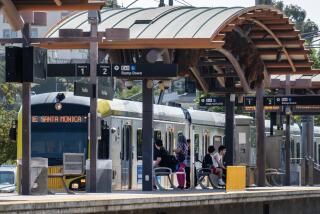No free rides
MAYOR ANTONIO VILLARAIGOSA wants to give Angelenos a free ride. His theory is that if you waive the fares on L.A. public transit for a week, people who might not otherwise take the buses and trains will give them a chance -- and find that they like it so much, theyâll leave their cars in the garage more often. In a perfect world, it would be a fine idea; in the real one, itâs a bust.
Villaraigosa recently asked the Metropolitan Transportation Authority to study the cost of his free transit proposal, which is modeled on a program in the Bay Area called Spare the Air. Created with the dual purpose of reducing emissions and introducing public transit to people who donât normally use it, the program goes into effect on days when smog is expected to exceed federal health limits. It has strong political support in the Bay Area, and in some ways it has been effective. Ridership has increased by between 8% and 10% during the six free days this year.
But free transit days havenât been free of problems or controversy. The most recent sparing of the air came during a blistering heat wave, which filled the buses and trains not only with commuters but with homeless people attracted by the air conditioning. Transit police also report a big uptick in crime and rider complaints on free days, according to the San Francisco Chronicle. Trains have been vandalized, passengers on badly overcrowded cars intimidated, while rowdy teens fight and toss food containers everywhere. Not exactly the kind of atmosphere to convince commuters that taking the train is an attractive alternative to driving.
Which may help explain why Spare the Air hasnât noticeably increased the passenger count when transit isnât free. Itâs possible that the free days have reduced traffic and emissions in the Bay Area, but such things are nearly impossible to measure, and if there has been an effect, it has been fractionally small.
But the worst thing about Villaraigosaâs plan is the cost. Although the local price tag isnât known, in the Bay Area, every free day costs $2.3 million in lost fares. Given that the MTA is running at a projected $131-million operating deficit and could soon face layoffs or cuts in service, thatâs a burden it can ill afford.
The best way to get commuters out of their cars is to create a public transit system that is fast, efficient and blankets the city. Building that kind of system costs money, which you donât get by waiving fares. Villaraigosaâs idea is a nice try, but the MTA board should see that it never leaves the station.
More to Read
Sign up for Essential California
The most important California stories and recommendations in your inbox every morning.
You may occasionally receive promotional content from the Los Angeles Times.










